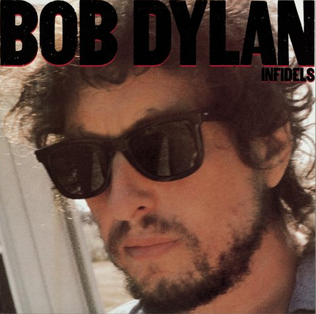This article originally appeared in the Huffington Post here.
If you remember the pointing finger songs of Saved (1980) and Shot of Love (1981), the din and drone of Dylan and the Dead anesthetizing half-filled stadiums or the inconsistencies of Knocked Out Loaded (1986) and Down in the Groove (1988), you might remember Dylan in the 80's at his most discombobdylanated.
But the release of A Tribute to Bob Dylan in the 1980s challenges the perception of Dylan falling to the mat in the decade of Ronald Reagan. With no obviously common sonic strings connecting these seventeen songs, producers Jesse Lauter and Sean O'Brien and an eclectic group of hipster rockers interpret tunes from Dylan's eight 80's studio albums, previously unreleased material and a cut from the Traveling Wilburys.
If the question at the heart of this project asks what was really off about Bob Dylan in the 1980s, the answer it returns is surprising. How we hear Dylan's supposed nadir says a lot about what distinguishes art and artists that last.

Dylan Uncovered
In the beginning there was Bob Dylan, and about a nanosecond later, there was an industry of Bob Dylan covers. (Expecting Rain lists all Dylan cover albums here.)
In the beginning there was Bob Dylan, and about a nanosecond later, there was an industry of Bob Dylan covers. (Expecting Rain lists all Dylan cover albums here.)
Recent years have seen a spike in these cover collections -- from Bryan Ferry and
Charlie Daniels to the exhaustive Chimes of Freedom spanning from Cash to K'naan to emo/pop punk bands' Listen to Bob Dylan (2005) and From Another World, which which brings together musicians from around the word to play Dylan using their native instruments and styles.
Great artists -- or artists with great aspirations -- must master the work of those who came before them in order to become masters themselves. This is the story of the rock and roll canon, and Dylan is its ultimate keeper.
Gone But Not Forgotten
The term canon was most famously applied to the Bible, addressing which materials were authoritative and which were not.
When it first started out, rock was all about covers and testing the possibilities of its emergent canon. The Beatles did Little Richard and Chuck Berry. Eric Clapton and the Stones did Robert Johnson. No James Joyce or Virginia Woolf without Plato and Hobbes. No rock and roll without roots.
Dylan is the towering figure of this transition not only because he mastered the masters, but because after Dylan, all rock stars would need to write and perform their own material to prove that they were for real.
Dylan was also the first of the major rock artists to curate his own canon. He pioneered the greatest hits formula in the late 60s and early 70. Biograph (1985) curated hits, previously unreleased cuts and liner notes by Dylan himself. Then came two decades (and ten volumes) of The Bootleg Series, comprised of outtakes and live or unreleased material.
All of rock's A-list followed Dylan's lead yet again. Now almost anyone who has made a record or two makes a box set case for careful review of his or her work.
A Can-Do Canon
Spin took the piss out of rock's canonical obsession with itself in its preview of the best rock box sets of 2013.
Spin took the piss out of rock's canonical obsession with itself in its preview of the best rock box sets of 2013.
As William Faulkner once wrote after receiving a three-CD 20th-anniversary edition of In Utero as a Christmas gift, 'The past isn't dead. It isn't even past. And this new Steve Albini mix is incredible...'
As much as canons ensure a common record of artistic achievement, they can also be impediments to creativity -- not to mention, as Spin makes clear, wildly inaccurate reflections about what made history.
Look at the biblical canon for what a canon can and cannot do: Once Scripture was canonized in the first century or two of the Common Era, the world exploded with creativity. Church Fathers shaped a movement so compelling that it usurped the belief system of the Roman Empire. Bereft of the Temple, the rabbinic movement reinvented Judaism, producing the Talmud, which has served as a common model for keeping law and lore alive for fifteen hundred years. But too much attention to canonical fundamentals leads to fundamentalism, a trend we see everywhere today.
What is true of religion is also true of art. Dylan's magic has been his endlessly restless interpretation of his own canon, inviting and even demanding the same approach from all who wanted to learn from it.
This restlessness not only led to many gems that Bob Dylan in the 1980s highlights -- "Death Is Not the End" (Carl Broemel), "Pressing On" (Glen Hansard), "When the Night Comes Falling from the Sky" (Lucius), "Covenant Woman" (Hannah Cohen) and "Dark Eyes" (Dawn Landes and Bonnie "Prince" Billy) to name a few -- but seeded the ground for a blossoming of excellent albums, a book, a film and rejuvenated touring in the 1990s.

Infidels (1983) emerged at the end of Dylan's most extreme evangelical phase. It's an album of both wonders and duds. "Jokerman," covered by Built to Spill on Bob Dylan in the 1980s, is one of its best cuts:
Well, the Book of Leviticus and DeuteronomyThe law of the jungle and the sea are your only teachers
Here is the canon as clear it could be -- legal, repetitive and immutable texts in the hard center of the Pentateuch tempered by the wildest of nature's blessings and dangers. These are the only teachers that Jokerman claims, but they are more than enough to learn everything he needs to know. Both by instinct and necessity, artists keep rediscovering Bob Dylan's canon for the very same reason.
This article originally appeared in the Huffington Post here.
No comments:
Post a Comment